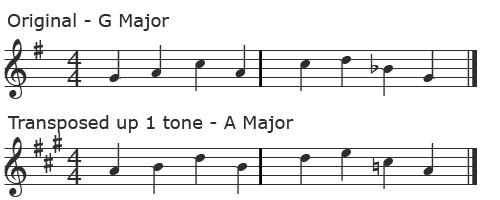Transposing for different instruments
When is a C not a C? When you are playing a transposing instrument!
On most musical instruments, if you read a middle C on a score, and finger a middle C on your instrument, the note that you play will be a “concert pitch” middle C. But when you are playing a transposing instrument,if you read a C and finger a C, the note that will be produced will sound like a different concert pitch note.
Take the Bb clarinet as an example. The note drawn as a “C” for a Bb clarinet, will sound the same as a Bb played on a concert pitch instrument such as a violin. Some of the more common transposing instruments include clarinet and trumpets (most commonly in B flat), horns (in F), and saxophones (commonly in B flat or E flat).
Why do they do this? Because instruments such as the saxophone come in various sizes – alto, baritone, etc. Each size of saxophone has the same basic fingering patterns, but at different pitches. To make it easier for saxophonists to switch between different types of saxophone, saxophone music is common written in the key of the type of saxophone for which it is intended.
To help those who play transposing instruments, within our Scales Practice app we have included an option to transpose for instruments tuned to a different pitch. This will allow you to hear the pitch at which different instruments would play each key signature/scale’s notes.
Below I briefly summarise how this transposition works. Note, this summary relies on you having a basic understanding of intervals. If you don’t understand these, there is plenty of information on the web including on Wikipedia).
Transposing for instruments in different keys
An accomplished player of a transposing instrument may be able to transpose at sight, but most players will need a transposed part written out for them.
You can do this in four steps:
1. Find the interval which you want to transpose for (between the two types of part). If you have a C part and want to transpose this for a B flat instrument, you will have to transpose the music up one whole tone to D. This will mean that when the instrument is playing a written D, it will sound a C. Make sure you are transposing in the correct direction – to compensate properly for the transposition built in to the instrument always transpose by moving in the opposite direction from the change in the part names.
If we look at the common instruments listed above:
- Clarinet and Trumpet – most commonly in B flat. To transpose for B flat instruments you would need to transpose C parts up one whole tone.
- Horn – in F. Transpose C parts up a perfect fifth interval to be read in F.
- Saxophone – in B flat or E flat. Transpose up a major sixth interval to be read in E flat.
2. Choose your key signature. The key signature will also need to change according to the interval between the two parts. For example, if you want to transpose a piece in C major up one tone, the key also moves up one whole tone, to D major.
3. Transpose each note in turn. The easiest way to do this is by counting lines and spaces – this should work as long as your key signature is correct.
4. Take care with accidentals – they will not necessarily be the same in both keys (for example a natural in one key might turn in to a sharp in another). Put the note on the line or space where it would fall if it were not an accidental, and then either lower or raise it from your new key signature. For example, an accidental B natural in the key of F major raises the note one semitone. If you were transposing up one tone to the key of G major, you would raise the C up one semitone to C sharp.
In the example below I have transposed a few bars of music in G Major for a B flat clarinet. The key signature has moved up a tone to A major (which has three sharps). I have also moved every note up one tone. I had to be careful with the accidental on the B flat. This lowers the note by one semitone. In the transposed version the B becomes a C, which has a sharp in the A major key signature. To lower this by a semi-tone I needed to add a natural accidental.
